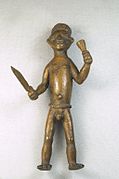Ihe osise Dan



.
Ihe mkpuchi
[dezie | dezie ebe o si]-
Nwoke ịgba ɔtɔ na-ejide mma na mpi,Museum nke Brooklyn
-
Mgbaaka ụkwụMHNT
Masks bụ ụdị nka kacha mkpa nke ndị Dan nke Liberia.[1] A na-aghọta na ha nwere ike mmụọ kacha ike, nke a na-akpọ ge ma ọ bụ gle
wunkirmian bụ nnukwu ladle emume nke a kpụrụ akpụ iji sọpụrụ otu ụdị nke ji mmesapụ aka ma ọ bụ ile ọbịa mara onwe ya. Onye nwe wunkirmian bụ onye a na-ewere dị ka "nwanyị na-ele ọbịa" nke mpaghara obodo ya. Na omenala, ọ na-agba onye ga-nyo ya
.[1]Curator Barbara C. Johnson describes the role of the feast ladle in a Dan feast: "At feast times [the wunkirle] marches with her spoon at the head of the line of women from her quarter. Each woman carries a pot of cooked rice or soup. The wunkirle either distributes to the food to the guests, or more frequently uses her ladle to indicate the distribution. At some feasts the wurkirlone of a village compete with each other in generosity by distributing small gifts of peanuts, candy, coins and other foods. The women dance at these times. The wunkirle's prestige may be indicated by her being carried in a hammock through the village by the women of her quarter. They also contribute gifts of their own, but always in the name of the wurkirle
.E wezụga ime ihe dị ka “ihe ngosi nke ngosi,” oriri na-egosi nwere ike ime ime ihe. [1] Dị ka Dan si kwuo, ladles na-agụnye du ma nwee ike nke wunkirle . wunkirmiam bụ maka ihe nkpuchi bụ maka ụmụ nwoke; wunkirmiam bụ onye isi nke njikọ na ike nke ụwa ike na akara nke njikọ ahụ. [2] Dị ka ihe egwu, a na-enye onye ọ àlà wunkirmian aha nke ya
Ụdị a na-ahụkarị nke wunkirmian nwere aka a kpụrụ dị ka isi mmadụ nke na-egosipụta njirimara nke mkpuchi buangle : anya dị warara na ihu oval. Ihu dị na ladle na-egosi otu nwanyị.
Isi osisi a kpụrụ akpụ n'elu pedestal ma ọ bụ mkpara
[dezie | dezie ebe o si]A kọrọ na ụfọdụ ndị na-eme ihe mkpuchi na-ebu isi ndị Janus chere ihu n'otu ọrụ. Ihu abụọ a na-ele anya n'akụkụ dị iche na-egosi ikike karịrị nke gle ịhụ n'akụkụ niile. [2]
Dị ka oriri oriri, a na-ewere isi ndị a dị ka ihe ime mmụọ dị ike nke na-arụ ọrụ dị ka ihe oriri maka du . E kere ụfọdụ dị ka ihe osise nke ndị òtù ezinụlọ nwụrụ anwụ nke gụnyere mmụọ onye ahụ.
Nkedo ọla
[dezie | dezie ebe o si]- ↑ Johnson (1986). Four Dan sculptors : continuity and change. San Francisco: Fine Arts Museums of San Francisco. ISBN 088401049X.
- ↑ Himmelheber (1960). Negerkunst und Negerkunstler. Braunscheweig: Klinkhardt & Biermann.
Ọ na-esiri ike ikpebi oge ochie nke nkedo ọla n'etiti Dan, ma o doro anya na omume ahụ malitere ma ọ dịkarịa ala na mmalite narị afọ nke 19 ma ọ bụrụ na ọ bụghị na mbụ. Ụfọdụ ndị ọkà mmụta kweere na ọ pụrụ ịbụ na ndị anyị bi n’Ebe Ọwụwa Anyanwụ Ụwa webatara omume ahụ na Dan. [1] Nkedo ọla bụ omume nke ndị oji Dan. N'ime obodo Dan, a na-enye onye na-ese ihe mgbe niile ọkwa dị elu n'ihi na ọ bụ ya na-ahụ maka ngwá ọrụ ugbo na ngwá agha. [2] A na-eme ihe nkedo brass n'abalị iji chebe ihe ahụ n'aka ndị na-ekiri ya. Brass-casters na-emepụta ihe ọla na-eji usoro wepụ-perdue, ma ọ bụ usoro wax furu efu .
Ntụaka
[dezie | dezie ebe o si]- ↑ Schwab (1947). Tribes of the Liberian Hinterland. Cambridge: Papers of the Peabody Museum.
- ↑ Johnson (1986). Four Dan sculptors : continuity and change. San Francisco: Fine Arts Museums of San Francisco. ISBN 088401049X.


